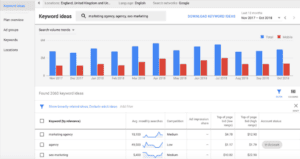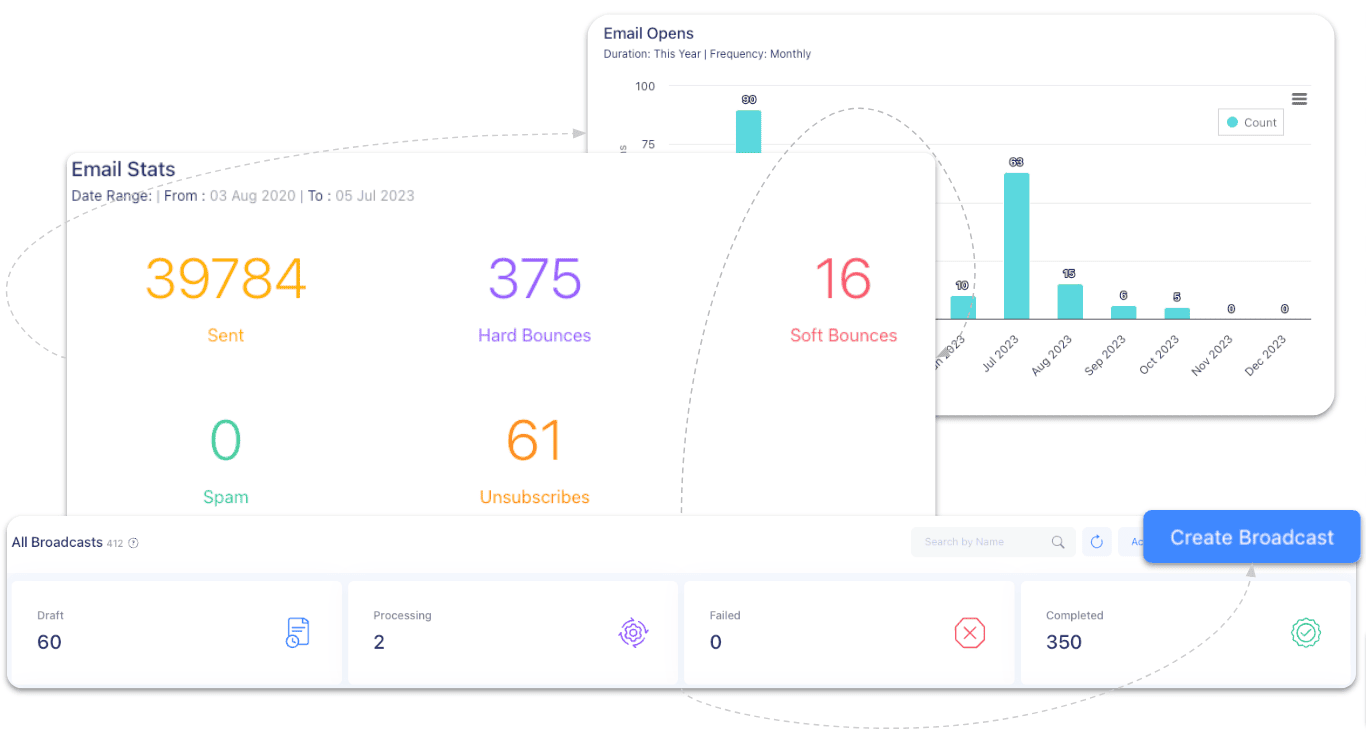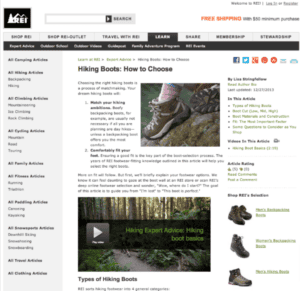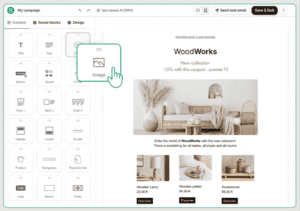There’s an old marketing saying that content is king.
While a lot has changed in digital marketing, even within the last couple of years, one constant is that content is still indeed king, especially eCommerce content marketing.
As an eCommerce business owner, you can get so preoccupied with creating, promoting, and tracking your products that content can fall by the wayside. This will be detrimental, especially if your competitors already have a solid content marketing plan.
Content marketing is incredibly common in today’s business landscape, with 70% of B2C marketers and 73% of B2B marketers relying on it.
You don’t want to be left behind, so what goes into building an eCommerce content marketing strategy, you ask? I’ll explain what you must know in this informative guide for building your first campaign.
In this blog post, we’ll explore eight key eCommerce content marketing strategies, and how each plays an important role in the success of your business.
Let’s go!
Table of Contents
Key Takeaways
- The most effective eCommerce content marketing strategies involve understanding your audience and setting goals, then tailoring content to your audience segments according to their needs and challenges.
- Creating a content strategy, harnessing UGC, expanding your reach on various social media channels, and relying on AI for content production can also benefit your eCommerce business.
1. Understand the Core Elements of eCommerce Content Marketing
Like building any solid structure, you must start with a good foundation. That’s why I want to get underway with this list of elements your content marketing must contain.
Brand understanding and guidelines
Your brand is about to go big time. If you’re the only one who has managed your brand to this point, focusing on content marketing will change that. You’ll need others to manage your social media and content.
If you haven’t already done so, now is an ideal time to assemble brand guidelines. The guidelines should delve into the crux of your brand, including what your company values are and what the brand should represent.
Beyond that, the brand guidelines should also detail:
- Brand tone
- Brand story
- Brand colors
- Logo and how/where to use it
- Brand typography
- Associated imagery
Audience data
Next, you need as much data about your potential customers as possible.
If you haven’t already done audience research, consider that before proceeding. You can survey your existing audience and have interviews with prospective customers to understand the needs of your target market.
You should use the audience data to build customer avatars or personas.
Each avatar represents the most prominent traits of your audience groups. You’ll find it far easier to market to Careful Carl and Eco-Conscious Erica than you will 1,000 unique audience members.
Dedicate some time to mapping your customer journey so you can understand how your leads convert to customers in the sales funnel. This information will dictate what kinds of content you’ll produce at various points in the funnel (such as for new leads in the research phase versus those on the cusp of a decision).
Marketing goals
Another component of a solid content marketing strategy is goal-planning.
Sit down with the major stakeholders within your eCommerce company and discuss your short- and long-term content marketing goals. Do you want to strengthen your branding, convert leads, or boost website traffic?
How you answer these questions matters, as certain responses dictate prioritizing specific types of content.
Content
Then there’s the content itself, of which there are seemingly endless kinds. Let’s go over your options:
- Blog posts
- Videos
- Whitepapers
- Case studies
- Infographics
- Podcasts
- Social media
- eBooks
- Industry reports
- Trends lists
- Guides
- Webinars
- Checklists
- Listicles
- Audiobooks
- Press releases
- Newsletters
Editorial calendar
Content is great, but it won’t get you far if you don’t know where to put it. If you aren’t careful, you can publish all your great content in one big flurry, overwhelming your audience and leaving you without anything else to post.
That’s why an editorial calendar, sometimes called a content calendar, is so valuable.
You can look ahead and determine exactly what you’ll publish and when. An editorial calendar helps you extend the duration of your content and avoid long gaps of no content.
Analytics
Reviewing the numbers is the only way to know if the content achieved your marketing goals.
If you didn’t get more leads or website traffic during your first eCommerce content marketing campaign, it’s time to sit down, figure out what went wrong, and retool your tactics until you achieve the desired results.
2. Develop a Content Workflow
Are you ready to build your first eCommerce content strategy? I’ll review what goes into it and guide you through the steps.
Step 1 – Goals
Remember, every successful marketing campaign begins with clear-cut goals. Since this will be your first content campaign, start with an easier goal. Attaining it will give you upward momentum that will help you knock even more goals out of the park.
Step 2 – Audience personas
Audience data is the backbone of any successful eCommerce content marketing campaign. As you tailor your product creation to your target market based on their pain points and needs, you should do the same with your content.
Using a basic example, new leads in the funnel will appreciate explainer videos about who your eCommerce store brand is and what you sell. Longer-term customers don’t need that kind of content.
They’d benefit more from long-form, in-depth, advanced content like eBooks, whitepapers, podcasts, or webinars.
Step 3 – Content audit
Strengthening your content marketing requires you to turn a hard eye to the content you’ve already published under your eCommerce brand in the form of a content audit.
An audit evaluates your product pages, blog content, landing pages, and other core content on your website and social media. As you assess each piece of content, you must make tough decisions.
Do you keep the content, leaving it as is? Do you keep it but update or retool it? Or do you delete it?
Don’t do anything yet; write down your plan. Go through each content and page on your site and report your decisions. Then, you can make a game plan of which content pieces to start with and which can wait until you have more time.
Deciding what stays and what goes isn’t a matter of preference. You should evaluate the performance of each piece, checking for traffic, conversions, and other results. If the content didn’t achieve any goals, you shouldn’t leave it as is.
I also recommend evaluating your SEO score in relation to the content. Tools like Yoast SEO or Surfer SEO can give you an SEO score for your content and suggestions for improvement, such as by adding images or keywords.
Step 4 – Selecting content
Next, you must choose the content from the abovementioned types that best achieve your marketing goals among your various audience segments. Make sure you experiment with different types of content, as it keeps your longer-term customers engaged.
Step 5 – Choosing content channels
Picking the type of content you want to publish is only half the battle. You also have to choose the best platforms or channels for each type of content.
For example, YouTube is a popular video channel, and so is Vimeo.
WordPress is the biggest platform for hosting blogs, but not the only one. You can always explore various podcast resources, from Podbean to Libsyn, Buzzsprout, Blubrry, Transistor, and Castos.
Most services that will host your content will likely require you to pay. Besides your budget, factors to consider are uptime versus downtime, ease of use, and features.
Step 6 – Building an editorial calendar
You already understand the value of an editorial calendar, so now it’s time to map yours out. Your content marketing plan is still in flux this early, so you don’t need to plan a tremendously long calendar.
Extend it by a month or two at most, especially considering your publishing content could change.
Step 7 – Documenting your content creation
It may seem unnecessary to document how to write blog content or record a branded video, but remember that the content creation process will not be entirely in your hands.
Having guidelines on how it’s done will help others stick within the prescribed rules and produce content that’s ready to publish out of the gate.
Read more: A Short and Sweet Guide to Content Marketing Automation
3. Craft Compelling Content
Writing content itself might be one of the above steps, but it’s so monumental that it deserves its own section.
Good content should be informative, educational, or entertaining. It should drive an action, such as subscribing to your email list or checking out a product.
These tips will help you produce more good content.
Use storytelling
Storytelling is one of your best friends in content production.
People love a good story, a fact that I sincerely doubt will change anytime soon (if ever). Connecting with your audience over a story can lead to more sales, with 55% of those who read your story more likely to buy later.
But wait, it gets better. Another 44% of your readers will post the story to share it. Then, a small but meaningful group of 15% will immediately buy your product.
That’s the power of a good story!
Repurpose old content
As you accumulate content, you should continue to perform content audits, identifying old pieces that could use some sprucing up.
You may have found additional research or information to bolster your main point in your whitepaper, or there have been enough changes to the original topic that warrant a follow-up podcast episode.
Repurposing old content breathes new life into it, giving it a second chance to connect with your audience and rank.
Write persuasively without being salesy
There’s a difference between writing to sell and writing to inspire someone to buy. Being persuasive doesn’t cram product specs down the reader’s throat. Instead, you present the benefits and let them come to their conclusion.
It may carry a greater risk—giving the reader free will to make their own choices means they might not buy your product—but writing persuasively will keep your readers engaged and interested in your products.
Consistency is key
One of the biggest tips I can give you is to publish content regularly, whether it’s YouTube videos, podcasts, or blog posts.
What “regularly” looks like for you will vary from business to business according to your audience preferences. Some audiences may appreciate content only once a week, while others will want it every other day.
You’ll learn through trial and error how much content is too much, then adjust accordingly.
Read more: 10 Content Marketing Tips to Make Your Day
4. Leverage Technology and Tools
A lot goes into eCommerce content marketing, perhaps more than you had realized. But that’s okay; you don’t have to do it alone. You have the power of technology on your side, and these tools are some of my favorites.
Brevo
Once called Sendinblue, the marketing tool now known as Brevo has features you need to launch your first eCommerce content marketing campaign successfully. Its marketing platform has:
- Email marketing
- AI email writing and sending
- Marketing on WhatsApp
- Custom embeddable forms
- Marketing automation
- SMS marketing
The Marketing Platform has four pricing plans: Free, free forever, Starter for $9 per month, Business for $18 per month, and Enterprise with custom pricing.
SEMrush

As SEMrush says, “Online marketing can be easy.” You only need a tool like it by your side.
SEMrush has a library of content marketing tools, including Topic Research, Brand Monitoring, SEO Writing Assistant, ContentShake AI (an AI-driven writing tool), and SEO Content Template.
Further, you can use SEMrush for social media, including:
- Influencer Analytics
- Social Inbox
- Social Content Ideation
- Social Analytics
- Social Content Insights
- Social Tracker
- Social Poster
SEMrush might be arguably most known for its suite of SEO features, many of which will help your eCommerce business as you launch content marketing campaigns.
Some of the tools include:
- On-Page SEO Checker
- Site Audit
- Bulk Analysis
- List Building Tool
- Backlink Audit
- Organic Traffic Insights
- Keyword Strategy Builder
- Backlink Gap
- Traffic Analytics
Google Keyword Planner

You’re getting the gist that keywords are a major part of eCommerce content marketing success.
Google Keyword Planner is a reliable tool for finding keywords your audience is searching for and basing your ad and marketing campaigns around those terms.
EngageBay

If your eCommerce business is on the smaller side, listen up. EngageBay is a marketing, sales, and service software for startups like yours. Its robust Marketing Hub has more of the features you need to drive your campaigns forward, including:
- Email A/B testing
- Site messaging
- Contact segmentation
- Push notifications
- Drip campaigns
- SMS marketing
- Web forms
- Landing pages
- Email marketing
- Marketing automation
EngageBay’s Marketing Bay prices are as follows with annual pricing: the Free plan for $0 (free forever), Basic for $11.95 per user per month, Growth for $45.99 per user per month, and Pro for $73.59 per user per month.
If you want to harness the power of its Service Bay and CRM & Sales Bay in addition to the Marketing Bay features, all-in-one plans with annual billing are Free for $0, Basic for $13.79 per user per month, Growth for $59.79 per user per month, and Pro for $110.39 per user per month.
Google Analytics

How is your content marketing campaign going? Get the answers you seek using Google Analytics. Here is some of the information this helpful tool can divulge:
- User behavior
- Ad attributions
- Monetization reports
- Engagement reports
- Acquisition reports
- Privacy-safe modeling
- Real-time reports
- Predictive insights
Read more: Content Marketing Funnels — The Key to Unlocking Your Brand’s Potential
5. Integrate User-Generated Content
More than 90% of consumers rely on those they already know to refer them to new products, user-generated content, or UGC, an increasingly important part of your eCommerce content marketing strategy.
UGC can include any customer-posted content, from video testimonials to reviews on a personal blog, social media posts about your products, unboxings, and the whole nine. To amplify this social proof, consider collaborating with UGC creators to elevate your brand authenticity and audience trust.
So, how do you get it?
Well, it has to come about naturally. You should always strive to produce content that generally gets your audience excited. If they love something enough, they’ll want to discuss it, so you get UGC.
You can also encourage your audience to share posts and reviews, offering incentives such as discounts or exclusive sales codes.
Once you have it, incorporate UGC into your email and social media content. You can post it on your website or even your blog. Seeing UGC might inspire some of your audience members to share their own.
Read also: 5 eCommerce Email Marketing Software to Help You Sell More
6. Optimize for Search and Social Media
I’ve skirted around eCommerce content marketing SEO throughout this guide, but now I want to dive into it earnestly.
I will have a companion piece on eCommerce SEO you should check out for more in-depth information, but for now, here are some pointers for making your content ready to rank:
- Perform keyword research to discover terms in your eCommerce niche or industry using competitor research and tools like Google Keyword Planner.
- Determine the difficulty of your keywords before implementing them, then add them to your blog post, title, headers, and URL.
- Write meta descriptions that describe your content in 140 to 160 characters.
- Incorporate hashtags in your social media posts.
- Optimize your images by adding alt tags and compressing their size.
- Produce landing pages on each product you sell.
- Test your website content before publishing.
- Seek guest-posting arrangements to expand your backlinks.
- Insert relevant links across your website in your content, using descriptors in the anchor text that inform your audience of where they’re going when they click.
Best practices for social media conversion and engagement
Another part of eCommerce content marketing success is spreading your content to social media, getting people hooked and following you.
Here are some ways to boost your brand awareness and mentions on social platforms:
- Keep your content engaging. In addition to posting your content, you should share third-party sources of news, trends, and insights you find interesting and that you know would appeal to your audience.
- Use hashtags to make your content easier to find, but don’t jump on a hashtag bandwagon if you don’t understand it or are unsure what it means or how to use it properly.
- Incorporate social commerce, selling your eCommerce goods through social media. The easier it is to facilitate a sale, the greater your chances of doing so.
- Share video content, especially on platforms known for their videos, like TikTok and Instagram.
- Go live occasionally, answering questions, discussing topics, or announcing a new product.
- Use paid advertising if it’s in the budget.
Read more: eCommerce Content Marketing and Why You Need It
7. Explore Innovative Approaches to Content Marketing
Once you’ve gotten the hang of eCommerce content marketing, you might want to take your campaigns to the next level.
The following pioneering approaches will help you do it.
Expand the formats you offer
If you aren’t already recording a podcast, why not? More than 464 million people listen to podcasts globally, which will only likely grow. Podcasts are an excellent way to expand on topics within your industry or niche in an engaging format.
You can share podcast snippets or transcripts as lead magnets and opt-in offers.
Webinars are another type of content you should add to your list if you haven’t already. You can monetize webinars by charging for access or selling replays or transcripts of the event. Likewise, you can use these materials as lead magnets.
Your webinar audience might be small at first. More than 80% of webinars get 50 or fewer attendees.
Use social proof more creatively
You’ve got some social proof, which is awesome, so now it’s time to use it to the fullest.
For example, why not use your testimonials or positive reviews to sell your products? You can upload a tracker on your website that tells readers each time someone buys something and which product they purchased.

8. Monitor and Measure Success
I’ve said it since the beginning: the best way to track the success of an eCommerce content marketing campaign is by reviewing the analytics. There are many to review, such as:
- Keyword rankings
- Click-through rate
- Bounce rate
- Social media engagement
- Average engagement rate
- Sales cycle length
- Average engagement time
- Email opt-in rates
- Sales conversion rate
- Backlinks
- Followers
- Content shares
- Conversions
- Content marketing return on investment
- Impressions
- Domain authority
- Page authority
- Brand mentions
- Traffic sources
- Inbound links
- Total time reading
- Views
- Unique pageviews
- Organic search traffic
Read also: eCommerce Email Marketing Simplified: 15 Examples + Tips
Examples of eCommerce Content Marketing
Are you ready to see some samples of eCommerce content marketing in action? Check out these five-star examples in a case study format.
REI
The premier outdoor brand REI proves the value of “how-to” content. You can find many pages below across the REI website, showing potential buyers how to find the right type/fit of specific outdoor products. In this case, it’s hiking boots.

The content is conversational yet educational and presented cleanly with numbers and bolding. There is also a video for those who want the information faster or want supplementary info.
Patagonia

Another outdoor gear brand that gets it right is Patagonia.
It regularly produces long-form content under its Patagonia Stories site, which features firsthand accounts of outdoor exploration and expedition.
The stories are inspiring and, more so, real, designed to speak to other outdoor enthusiasts and help them foster a true love of the outdoors.
Etsy

Likewise, once upon a time, Etsy had a feature called Etsy Journal, a branch of its site that offered “ideas and inspiration for creative living.”
Readers could explore gift ideas, home and living, style, weddings, and shopping guides.
However, these long-form articles weren’t just a bunch of product links thrown at you with no context. There was a narrative weaved around it that made the recommendations seem like they came from a friend or a trusted confidant.
Read more: 50 Content Marketing Quotes to Get You Fired Up
Conclusion
A cohesive eCommerce content marketing strategy can open many doors for your business. You can rely on content to build stronger relationships with leads, increase conversions, and improve relationships with existing customers.
Innovating and adapting to new content marketing trends is the key to staying on the cutting edge and giving your competitors bigger shoes to fill.
EngageBay is an all-in-one marketing, sales, and customer support software for small businesses, startups, and solopreneurs. You get email marketing, marketing automation, landing page and email templates, segmentation and personalization, sales pipelines, live chat, and more.
Sign up for free with EngageBay or book a demo with our experts.
Frequently Asked Questions (FAQ)
1. How does content marketing impact eCommerce sales?
Content marketing informs eCommerce sales by forging a stronger connection between brand and consumer, providing more information to inspire customers to buy, and driving loyalty to ensure repeat purchases.
2. What are the best content formats for eCommerce brands?
All forms of content work for eCommerce, but visual types of content, from email newsletters to videos, eBooks, and blogs, are especially effective.
3. How often should eCommerce businesses refresh their content?
Reviewing your content’s performance once or twice a year and updating it accordingly doesn’t hurt.
4. What are the best metrics to measure the success of eCommerce content marketing?
Tracking KPIs like organic traffic, social media followers, brand mentions, bounce rate, Net Promotor Score, and conversion rate optimization will indicate your campaign is successful.

